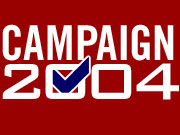Audio
Photos
More from MPR
Your Voice
| ||||||||||||||||||||||||||||||||||||||||||||
Supreme Court allows Independence Party candidates to stay on ballot
September 27, 2004
Two dozen Independence Party candidates for the U.S. Congress and the state House of Representatives have been cleared to appear on the ballot this November. The state Supreme Court ruled on Monday that a little-known election law could not be used to block the candidates from appearing in the general election even though they failed to meet a minimum threshold of voter support outlined in the law.
St. Paul, Minn. — The court's ruling came within hours of oral arguments from the Independence Party and Minnesota Attorney General Mike Hatch. Although the two were technically on opposing sides, Hatch ended up supporting a significant portion of the IP's contentions, including the claim that the threshold law violated the Minnesota and the U.S. constitutions.
IP chair Jim Moore praised the court decision and said it clears the way for his candidates to compete this fall.
"This is just another example of yet another hurdle that we thought was thrown in front of us unjustly. The Supreme Court agreed with us. And this unjustice has been tossed aside and our candidates are back to providing Minnesotans with an alternative, again, to the gridlock that we're seeing in St. Paul," Moore said.
The IP is fielding 21 candidates for seats in the state House and three candidates for the U.S. Congress. Earlier this month, Secretary of State Mary Kiffmeyer had ruled -- with Hatch's support -- that state law effectively blocked those candidates from advancing. The rarely-applied statute requires that at least one of a party's candidates reach a certain threshold of support in the primary elections. The threshold is defined as 10 percent of the vote earned in the current candidate's district, on average, by the party's slate of statewide candidates in the previous election.
In this year's September 14 primary, no IP candidate hit the mark. But even Hatch, when pressed by the court, acknowledged the law suffered from constitutional deficiencies. Hatch says the state has an interest in winnowing the candidate rosters and requiring particular candidates to show some level of popular support. But he says the law is defective because the thresholds vary from party to party and would be based on the past performances of candidates who may or may not be running again.
Moreover, says Hatch, if just one of a party's candidates meets the law's requirements, all of that party's candidates can advance.
"The problem here is we're not saying one percent of the vote of the election, we're not even saying ten percent of the vote of this election, we're saying 10 percent of the general election vote in the last election. And by the way, it doesn't even have to be your ten percent; it could be the percentage requirement of some state rep running up in northern Minnesota," Hatch said.
Hatch points out that the Green Party, because it had a low showing in the last statewide election, therefore faced a lower threshold. One candidate earned the required votes, clearing the path for all Greens to proceed. Yet, in general, the Greens had fewer votes than the IP candidates, who faced a higher threshold because of the relatively strong showing of their gubernatorial candidate, Tim Penny, in 2002.
The Supreme Court didn't elaborate on its reasoning in the order it released. It said only that the law cannot "constitutionally be applied to deprive Independence Party candidates a place on the general election ballot."
Brian Hanf, an IP candidate from the Twin Cities suburbs, received only 30 votes in the primary, which he attributes to low voter turnout in general and his lack of a primary challenger. Hanf says the uncertainty created by the court case forced his campaign out of stride, particularly since it deprived him of much-needed public campaign financing.
"I had to cancel all of my advertising that I was planning, all of my literature that I was planning on purchasing. I actually ran out during this period of time and just can't afford to purchase any more. So it's a huge blow to the campaign's momentum," he said.
Hanf says with the Supreme Court ruling in the IP's favor, he expects just under $4,000 in public financing to flow his way, and he says he's eager to return to the campaign trail.
|
News Headlines
|
Related Subjects
|


